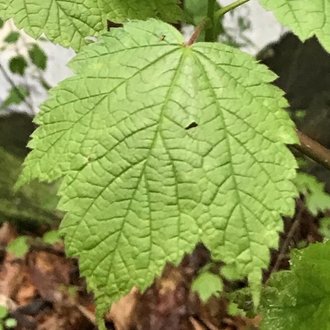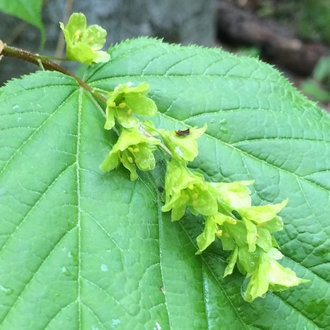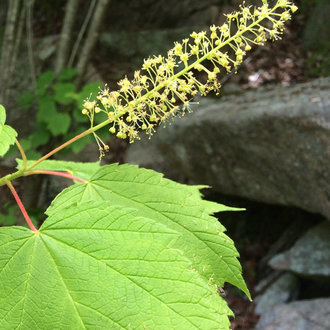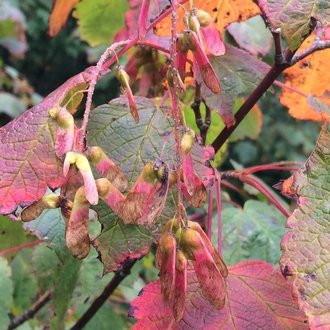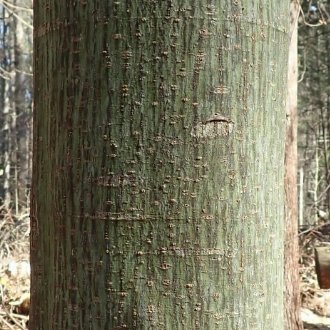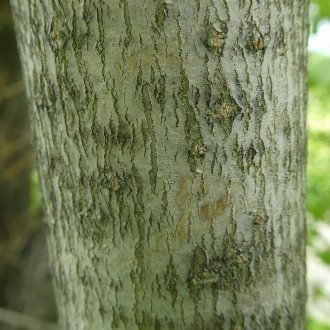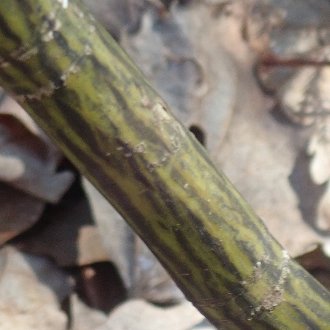Striped Maple vs Mountain Maple
This guide is under construction and has not been published yet. It may have errors. When in doubt, double-check other sources for definitive ID.These two species frequently occur in the same habitat as understory shrubs or small trees. They are easily distinguished by bloom, and with slightly more effort, by leaf or bark texture. Although there is overlap in size and growth habit, A. pensylvanicum is more likely to grow taller and have a single, straight trunk, whereas A. spicatum is more likely to have a leaning trunk and/or a shrubby, sprawling habit. Mountain maple is more restricted to northern hardwood forests and boreal forests, characteristic of cool, moist sites, ranges farther north and, in the north of its range, much farther west. Striped maple can grow in all of the same northerly forest types, but also ranges into drier conditions and forest types containing oaks.
Striped Maple (Acer pensylvanicum) | Mountain Maple (Acer spicatum) |
A small maple that grows as a large shrub to medium-sized tree. Highly shade-tolerant. Found in cool forests of the northeast and at higher elevations in the Appalachians. | An understory shrub or small tree native to the northeastern U.S. and northern Midwest, and also found at high elevations in the Appalachians. |
Serrations at leaf margins very fine. Leaf texture also very fine. Photo © Charlie Hohn, CC BY 4.0. | Coarser serrations on leaf margins. Leaf texture also looks coarser. Photo © Summit Metro Parks, CC BY 4.0. |
Blooms in a dropping cluster of relatively few flowers. Blooms earlier. Photo © Derek, CC BY 4.0. | Blooms in an erect spike with numerous flowers. Blooms later. Photo © Derek, CC BY 4.0. |
Samaras spread farther horizontally and are less downward-oriented. Usually green. Often have a visible depression in the seed. Photo © Pete Grannis, CC BY 4.0. | Samaras hang downwards more and spread horizontally less. Often red in color. Seed tends to look fuller and rounder. Photo © Charlie Hohn, CC BY 4.0. |
Bark is conspicuously striped. Photo © Lynn Harper, Public Domain. | Except on small trunks and some smaller branches, bark is not as conspicuously striped, only with some vertical cracks. Photo © raffib128, Public Domain. |
Young trunks and smaller branches have a bolder striping pattern with coarser or wider stripes, varying in color from bright white / forest green to pale green / brown, but never strongly reddish. Photo © Lynn Harper, Public Domain. | Young trunks and smaller branches may display a striped pattern, but tend to have a more reddish color overall. Stripes, if present, are finer or narrower. Photo © Nart Barileva, Public Domain. |
References & External Resources
These short lists show only links helpful for ID. For a complete list of references and resources also covering other aspects of ecology, visit the links section of the full article on each plant, which is the first entry here.




